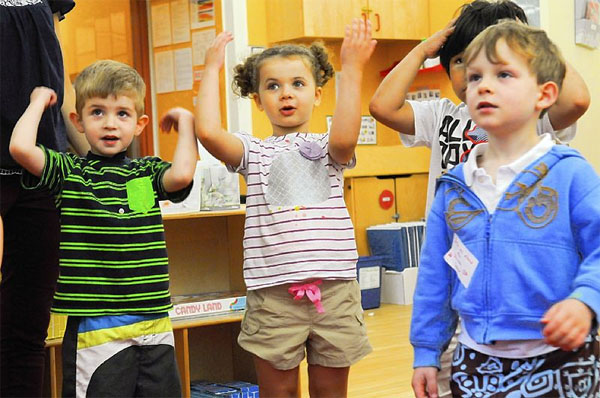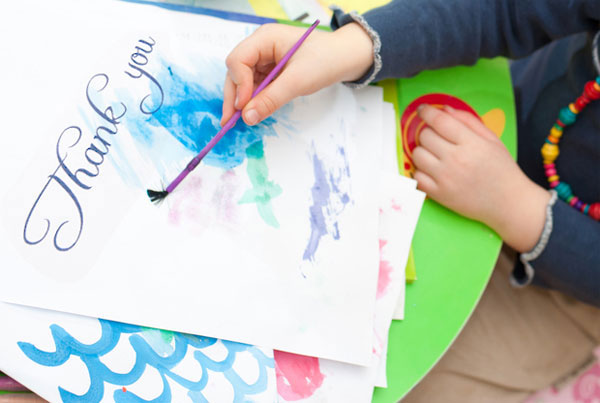Inculcating good manners in children is a very important aspect of parenting. Let us take a look at top 30 simple activities to teach good manners to children.Good manners are important in life and for living. They help you get along with others comfortably and also help you get treated well. Teaching these to children is a daunting task because if you continuously tell them or expect from them, it is not going to happen. You need to do something so that
common etiquettes become
habits of your children. Here are some fun activities that you can carry out and teach good manners to your children.
________________________________________
In this articlePretend a PartyGive Points to Each OtherPlay a Game for Sincere ApologiesAdd Beads to a Ribbon for Expressing GratitudePlay Formal Dinner TimePhone EtiquettesPlay the Good Manner SongPut a Good Manner Chart on the FridgePlay ‘Mind your Manners’Practice What you Preach'I Caught You Being Good 'JarDevelop a ScheduleUse Activity SheetsCreate a Tree of Good MannersCreate a Garden of Good MannersGood Manners QuestionnaireGood Manners JournalA to Z of Good MannersGood Manners SynonymsParagraph WritingGood Manners ObservationAppreciating Good MannersPersonal Good MannersGood Manners Promise NoteResponsibility NotePlaytime RulesTable MannersStreet MannersManners While VisitingGood Manners Picture Book________________________________________
1. Pretend a Party
Throw a pretend party to help your child learn about gracious greetings. You can set the mood with candles and balloons. Let your children ring the bell and enter the house one by one keeping a little bit of time difference between. Show them to use the techniques like the first impression which includes not just saying ‘welcome’, but also the eye contact and the warm smile that you give to the guests.
2. Give Points to Each Other
Make a common board where everyone can give points to the one who showed manners inside the house. Let it be a point of discussion along with giving away rewards to the one who gets the maximum point. Depending on your family atmosphere and the nature of your kids, you can opt for positive consequences.
3. Play a Game for Sincere Apologies
Make a list of things usually kids do and then add some which need and do not need
apology. Write them on small paper pieces and put them in a bowl. Let your child take out a chit and you should read out the statement. Now let your child guess whether that action needs an apology or not. If the guess is right, give her one point and for sincerity and eye contact you can give one bonus point too.
4. Add Beads to a Ribbon for Expressing Gratitude
Take a ribbon of your child’s favourite colour and keep some beads. Whenever your child says ‘Thank You’ or shows gratitude in some or the other form, add a bead to her ribbon. You can tie a knot if your child does not show the right gratitude when needed.
To teach your child the normal dining room do’s and don’ts, it is good to organize a formal dinner at least once a week and let your child practice how she should behave in parties, restaurants or when visiting others house for dinner. She will get used to these very quickly.
6. Phone Etiquettes
Nowadays, you need to teach your child how to speak to someone on the phone. You can pretend to be her friend or someone else calling on the phone. Let her answer the call and once she is done you can show her what part was right and what needed correction.
7. Play the Good Manner Song
You can find it on the internet or even in the market. Play it for your child often so that she learns what needs to be used and when.
8. Put a Good Manner Chart on the Fridge
Make a chart that says about the
good manners and where, when and how they should be used. Let your child take the initiative and ask you to revise them often.
9. Play ‘Mind your Manners’
Board game ‘Mind your manners’ is a good way to help children learn good manners in a playful way.
10. Practice What you Preach
‘Practice What you Preach’ is an activity that will be in action all through the day and night. Use the words and expression for good manners always and your children will follow suit.
11. 'I Caught You Being Good 'Jar
Ask your child to get one jar and label it as ‘I Caught You Being Good’. Whenever your child exhibits good manners, write it on a piece of paper and put it in this jar. By the end of the month, count the total number of chits in the jar. Give rewards to your child based on the number of chits in the jar. More the number of chits the jar contains, a higher number of rewards your child gets.
12. Develop a Schedule
Developing a proper schedule can help to cultivate good manners in your children. Sit with your child and draft a schedule along with the routine activities and timings. This schedule should include all the timings for the activities that are ought to be carried out by the child from morning till the bedtime. For example, the schedule should include timings for getting up in the morning, freshening-up, having breakfast, going to school, having lunch, rest time, play time, homework time and so on. You must mark if the child is carrying out all the activities as per the schedule on the calendar. If the child is regular in carrying out all the activities on time, he or she should be given rewards for the same. Developing a proper schedule for daily activities can help to inculcate good habits and manners in children.
13. Use Activity Sheets
Download the ‘Good Manners Activity Sheets’ from the internet and carry out these fun activities with your child. Such activity sheets can help you to teach important good manners to your child. Such activity sheets help children to learn what good manners are, the difference between good and bad manners, colouring pages etc.
14. Create a Tree of Good Manners
Ask your child to create a ‘Tree of Good Manners’. It is a very simple activity. Ask your child to draw a tree and write at least 5 good manners on it. Once the child finishes writing good manners on the tree ask him or her to colour the tree. Ask your child to stick the tree at a relevant place in your house so that he or she can read it every day.
15. Create a Garden of Good Manners
Ask your child to create a ‘Garden of Good Manners’. Your child can take an empty box and paint or stick flowers and grass on it. On each of the flowers in the garden ask your child to write one good manner. You child can place this creative art near any of his favourite places in the house.
16. Good Manners Questionnaire
Ask your child to create a questionnaire on good manners. It should contain at least 5 to 10 questions on good manners. Such questionnaires can include questions like ‘What is the importance of being punctual in life?’, “Why is it necessary to say''please” and thank you”? etc. After your child prepares the questionnaire, you can tell your child to ask these questions to at least 5 individuals and note down the responses in his book. After the child completes this activity, you must go through the responses and give suitable feedback and reward to your child.
17. Good Manners Journal
Ask your child to maintain a ‘Good Manners Journal’. Tell him or her to note down the activities that he or she carries out and at the same time the good manners that he or she exhibits every day. Check your child’s journal and give him little but useful rewards every day. Such rewards can include little gifts like new pencils, rubbers, crayons and other useful stationery supplies.
18. A to Z of Good Manners
Take a piece of paper or you can also do this activity in the ‘Good Manners Journal’. Name all the good manners starting from the letter ‘A’ to ‘Z’. For example, you can write the phrase ‘Appreciating Others’ for letter ‘A’, ‘Bringing-up’ for letter ‘B’, ‘Courtesy’ for letter ‘C’ and so on.
19. Good Manners Synonyms
Ask your child to write down in his Good Manners Journal the synonyms for Good Manners. Discuss these synonyms with your child once he or she is done with writing these synonyms.
20. Paragraph Writing
Ask your child to write about 8 to 10 lines about at least one good manner every day or every alternate day. Ask your child to read-out these 8 to 10 lines aloud. This task can not only help you to inculcate good manners in your child but also improve his or her writing and reading skills.
21. Good Manners Observation
Ask your child to observe good manners in his or her 5 friends. Tell him or her to write down the name of his or her friend in the Good Manners Journal and note down at least one good manner in his or her friend that was observed by him or her. After your child finishes listing down the good manners that he or she has observed, ask him or her to read it out in front of you.
22. Appreciating Good Manners
Ask your child to approach each of his or her friends and give a chocolate to each one of them. Let your child know that he or she should appreciate the good manners in them while giving the chocolate.
23. Personal Good Manners
Make a checklist of good manners that your child should observe for self-improvement. Do not forget to tick the checklist when your child observes such manners every day. Give your child rewards if your child is successful in observing such manners every day without fail.
24. Good Manners Promise Note
Ask your child to write a promise note on at least five good manners that he or she would observe at home. Give one star for each day in your child’s Good Manners Journal for observing these manners. At the end of the month count the number of stars and give little gifts corresponding to that number to your child.
25. Responsibility Note
Ask your child to write a responsibility note on the good manners that he or she is responsible to follow in his or her school. Encourage your child to write at least 10 Good Manners that he or she is responsible to follow in the school. If your child is able to write such 10 manners, you must reward your child. If your child is unable to complete the list, you must help him or her to complete it.
26. Playtime Rules
Teach your child about the fair-play rules. Whenever your child goes out to play, ask him or her to observe these rules. When the playtime is over, ask your child to come back home and then write down the playtime rules that he or she followed or observed in his Good Manners Journals. Give little gifts if your child exhibits best playtime rules.
27. Table Manners
Teaching table manners is one of the important aspects of teaching good manners to children. Every day after lunch or dinner, tell your child about the importance of each table manner and ask him or her to note it down in the journal.
28. Street Manners
Nowadays, a lot of videos on teaching good manners to children are available on the web. You can watch animated videos based on teaching street manners to children. Watching such videos can develop interest in your child to learn and imbibe such manners faster.
29. Manners While Visiting
When you are visiting a friend or relative with your child you must discuss the visiting manners well in advance. Ask your child to note down top 10 manners that he or she should follow while visiting someone’s place. Tell him or her that you will give him or her a surprise gift if he or she behaves well. If your child carries himself or herself well during the visit, give him or her a special gift.
30. Good Manners Picture Book
Ask your child to create a small picture book depicting different manners. You can get a small scrap book and ask your child to find pictures that depict different manners. Ask your child to stick this picture in the picture book and write something about each picture in the book.
The main reason behind children behaving in a well-mannered way is the environment in which they are brought up. So, children imbibe good manners faster when they grow in a refined and a positive environment. To develop such an environment at your home, you must follow the above-mentioned activities regularly. You will definitely see a change in your child if you make such activities a part of your life. Good luck and happy parenting!
How to teach good manners to children? What are the benefits of teaching good manners during early childhood? Which activities can help to teach good manners to children? Discuss here. 






























